The Andyson N500 Titanium PSU Review: High Efficiency For The Common PC
by E. Fylladitakis on October 8, 2015 8:00 AM EST- Posted in
- Cases/Cooling/PSUs
- PSUs
- 500W
- Andyson
- 80Plus Titanium
Hot Test Results
Switching over to our hot testing results, as we see in the following tables, the N500 Titanium displays excellent stability and delivers very good power quality, even when thermally stressed. The maximum voltage ripple on the 12V line is 52 mV at maximum load, less than half that of the design limit (120 mV). Strangely, the 3.3V line always displays a ripple of 16 mV, regardless of the unit's load. The maximum recorded ripple on the 5V line is 26 mV, nearly half of the design limit (50 mV).
Voltage regulation is very strong on the 12V line, with a regulation of 0.75% across the load range. On the other hand, the regulation of the minor voltage lines is considerably worse, at 2% across the load range, but that remains a very good performance figure for such a PSU.
| Main Output | ||||||||
| Load (Watts) | 111.18 W | 277.71 W | 414.62 W | 551.13 W | ||||
| Load (Percent) | 20.21% | 50.49% | 75.39% | 100.21% | ||||
| Amperes | Volts | Amperes | Volts | Amperes | Volts | Amperes | Volts | |
| 3.3 V | 1.91 | 3.38 | 4.78 | 3.38 | 7.17 | 3.33 | 9.57 | 3.32 |
| 5 V | 1.91 | 5.16 | 4.78 | 5.12 | 7.17 | 5.07 | 9.57 | 5.05 |
| 12 V | 7.84 | 12.1 | 19.61 | 12.09 | 29.41 | 12.05 | 39.22 | 12.01 |
| Line | Regulation (20% to 100% load) |
Voltage Ripple (mV) | |||||
| 20% Load | 50% Load | 75% Load | 100% Load | CL1 12V |
CL2 3.3V + 5V |
||
| 3.3V | 1.8% | 16 | 16 | 16 | 16 | 16 | 20 |
| 5V | 2% | 20 | 22 | 26 | 26 | 20 | 34 |
| 12V | 0.75% | 30 | 32 | 36 | 52 | 48 | 30 |
We should mention that this PSU does not have a clear temperature rating. This most likely means that it has been rated at 40°C, as this is the commercial computer PSU temperature standard. However, in order to match the 50°C rating of several high-end products, we perform our testing at temperatures higher than 45°C. We could reduce the ambient temperature of our hotbox testing but we chose not to do so as the results would then not be comparable to those of our previous reviews.
According to our results, it does not look like Andyson would have any trouble giving this PSU a clear power output rating at 50°C. The N500 Titanium can maintain its output and strong performance within a very hot environment. It lost only 0.55% of its average energy conversion efficiency, which dropped to 93.55% across the nominal loading range. The drop is evenly distributed across the load range and does not increase in effect as the load increases, suggesting that the PSU's capacity is virtually unaffected by the high environmental temperature.
The internal temperatures of the N500 Titanium do go high with the unit operating inside our hotbox, reaching heatsink temperatures over 80°C at maximum load. Thermal performance is a little worse than before, with widened temperature delta's by about 15%, indicating that the cooling system of the N500 Titanium is getting a little stressed. Still, the fan does not overwork itself. It does spin faster and gets louder than before, but it does not really go over 75% its maximum speed. Apparently, Andyson is not willing to sacrifice the acoustics performance of the PSU unless it is absolutely necessary and these temperatures are not high enough to have an impact on the PSU's longevity or, apparently, its performance.


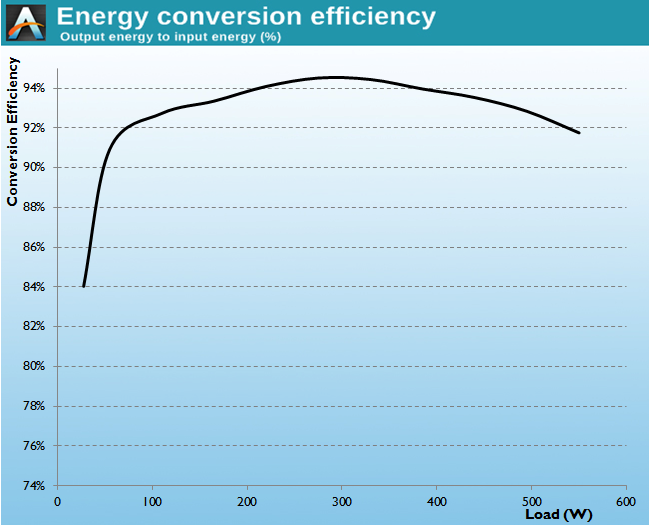
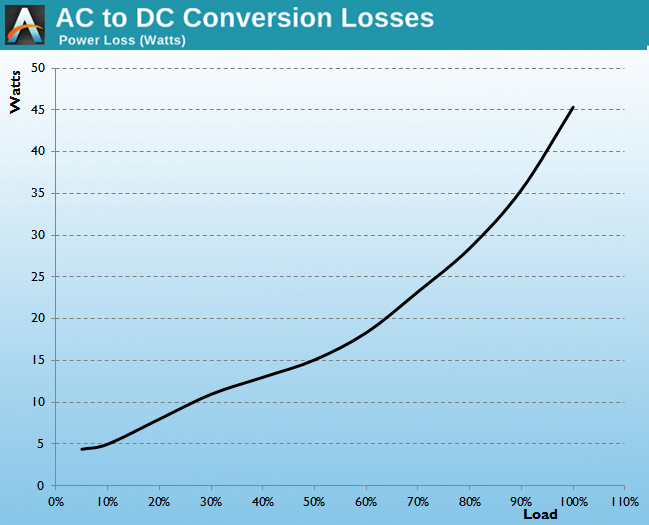
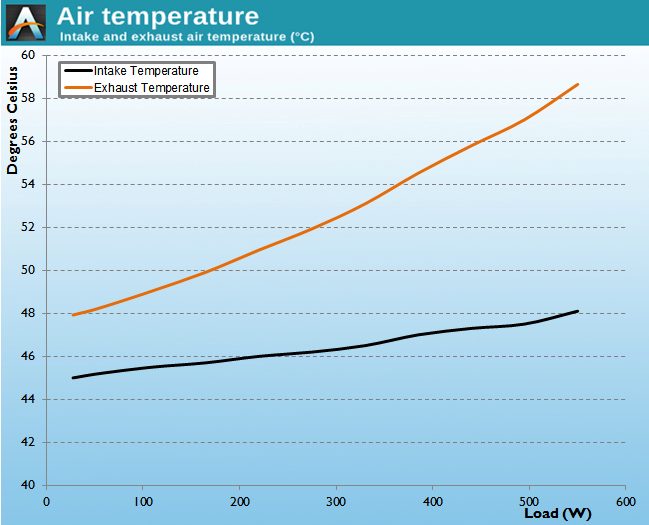
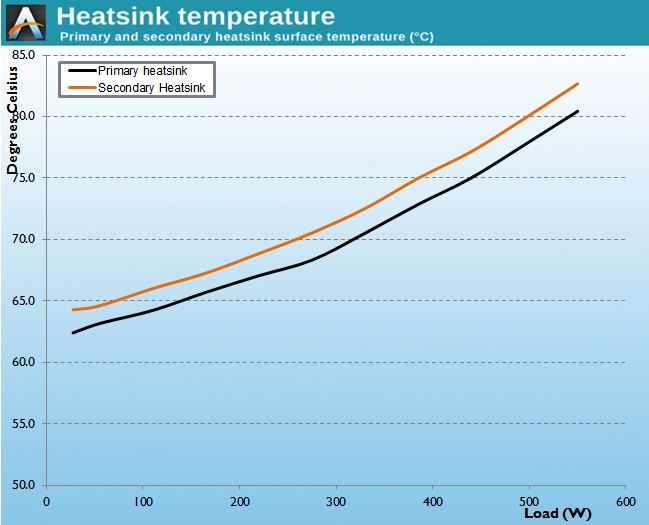
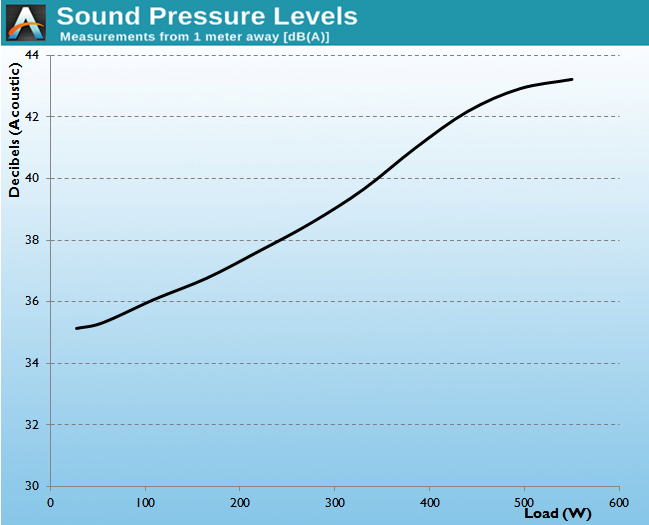








46 Comments
View All Comments
Mark_gb - Friday, October 9, 2015 - link
80+ Titanium requires 90% @ 10% load, 92% @ 20% load, 94% @ 50% load, 90% @ 100 load, on 115v.The only 80+ 85% requirements are 80+ Silver @ 20% load, and 80+ Bronze @ 50% load.
Daniel Egger - Thursday, October 8, 2015 - link
This is hands down the most interesting PSU reviewed on AT ever and I could not disagree more about the assessment that his might not even pay off compared to the 80Plus Gold PSU (you're even suggesting going higher with the wattage which means even higher losses at usual power levels!). Here in Europe we typically pay 23+ cents per kWh and rule of a thumb is 1W 24/7 power draw will >2€ per year; if you have devices running permanently or huge efficiency gains you can easily save 10€ per year, in some cases even 25€ or more.I've done lots of tricky conversions and downsizings in order to keep energy use down as much as possible and this is a very simple and cheap solution compared to all others so this is an instabuy for me (if I can actually locate one).
DanNeely - Thursday, October 8, 2015 - link
Keeping your computer at full load really is the only situation where going above gold will pay for itself; especially in places with cheaper power. The average price in the US is ~12c/kWh, or $1/watt year. At our prices platinum units generally took 4-6 years to break even on a 24/7 full load box; and never would if your computer spent most of its time at idle/standby/off. Hitting the titanium standard without bumping up the price a lot makes this one a much better deal at full load. If your box spends most of it's time at idle or off, the 2-4W average savings will push your baseline break even point out to between several years (24/7 idle, EU power prices) and never (off when not in use, US power prices).As Arbie's noted the amount of time you need to run the heater vs the air conditioner can tip the scales a decent amount either way, and that's very geographically dependent.
Daniel Egger - Thursday, October 8, 2015 - link
I disagree about the load. There're actually several aspects to this: More efficient PSUs are only available at higher ratings however most of them are at the same time abysmal at low loads where low is also defined as a percentage of the maximum rating. Titanium raises the bar tremendously above Platinum because it adds the quite important 10% tier where most of the Platinum PSUs plain and simply suck.Essentially there're only three options for best efficiency:
- Take the smallest possible PSU with a gold rating
- Use a PicoPSU/MicroPSU with a crazily efficient power brick
- Take this PSU (if it's not completely overkill for the system which it might very well be)
I've optimized numerous systems in my home, not only because of the power bills but because I'm in generally interested in efficiency in the hope that we can actually preserve the planet long enough for my grandchildren to have a decent life. From that experience I can tell you that a carefully chosen PSU alone can make a huge difference; with careful tuning and by replacing the PSU my Sandy Bridge based virtualisation environment and home server (24/7 on) went down from an already decent 75W to a nice 35W; the 20W that came from the PSU alone save 40€/year.
Just for kicks I tried powering my small gaming and HTPC with a 700W platinum PSU, in idle it used around 50W, in FurMark 200W, while my 300W bronze PSU only sips 25W in idle and 150W in Furmark. Now that system only runs sporadically but that's still a whopping difference.
I know AC and heating can make a huge difference (I'm also operating servers professionally) but in my home (and for the specific topic we're discussing) it really does not matter; a properly built home has to stay reasonably cool even without AC, so I don't have one.
Arbie - Thursday, October 8, 2015 - link
I would certainly pay extra for a very-high efficiency PSU. All the arguments I've seen regarding the cost of electricity ignore two important factors. First, unless you need heating in your room, the power dissipation of your rig has to be paid for about THREE times. Once for its own electricity, then 2X that for your air-conditioner to remove that heat. Another factor is that you may have to overcool several other areas to keep your computer room livable. Then there's comfort - it's no fun having cold A/C blowing on you much more than necessary.Of course you have to consider the deltas, proportionate gains, and costs - but a high efficiency PSU can be a better choice than you might think at first.
Murloc - Thursday, October 8, 2015 - link
well the heating is not a problem in most of the developed world. It's better to invest in recladding of old buildings really.Also overcool several other areas? Don't you have thermostats in each room?
In most of the world there isn't central air con outside of big buildings anyway so it doesn't matter.
SodaAnt - Thursday, October 8, 2015 - link
Central air con is pretty common in the US. Main issue with it is that you have to cool the whole house even if its only one room that's hot, or if you're only staying in one room.DanNeely - Thursday, October 8, 2015 - link
Central/forced air heating/AC is common in the US. At least in older construction a single thermostat is common. However, in most cases you'll have some ability to adjust the per room airflow by varying how open the vents are. If you've got a small massively overcomputed mancave you might be able to swamp the adjustability limits; but they generally are good enough to keep temperatures constant in a normal sized house.Timbrelaine - Sunday, October 11, 2015 - link
An efficient PSU can also help keTimbrelaine - Sunday, October 11, 2015 - link
Whoops. I meant to say:An efficient PSU can also help keep fan noise down and lifespan up. If lost productivity from fan whine/failure is large then a modest investment in an efficient PSU is a bargain.